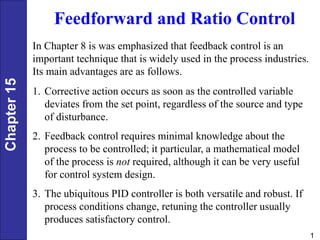This document discusses feedforward and ratio control. It begins by noting some disadvantages of feedback control, including that it does not provide predictive control for known disturbances. Feedforward control aims to measure and compensate for disturbances before they impact the process. Ratio control maintains the ratio of two process variables like flow rates. The document provides examples of designing feedforward controllers based on steady-state models like material balances, and based on dynamic models using transfer functions. It also discusses ratio control implementation and considerations like ensuring proper gain settings.







































![Chapter
15
40
•In view of Eq. 15-58, should be set equal to the estimated
dominant process time constant.
Step 3. Fine tune and .
• The final step is to use a trial-and-error procedure to fine tune
and by making small step changes in d.
• The desired step response consists of small deviations in the
controlled variable with equal areas above and below the set
point [1], as shown in Fig. 15.17.
• For simple process models, it can be proved theoretically that
equal areas above and below the set point imply that the
difference, , is correct (Exercise 15.8).
• In subsequent tuning to reduce the size of the areas, and
should be adjusted so that remains constant.
1
τ
1
τ 2
τ
1
τ
2
τ
1 2
τ τ
1
τ 2
τ
1 2
τ τ
](https://image.slidesharecdn.com/1496818-221105090502-47c7d190/85/1496818-ppt-40-320.jpg)


